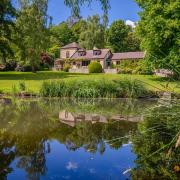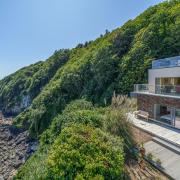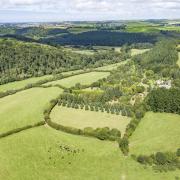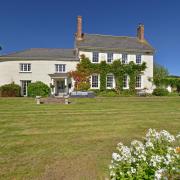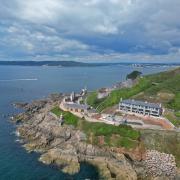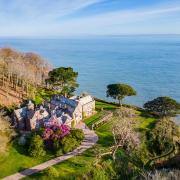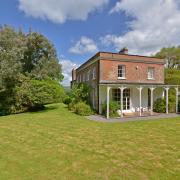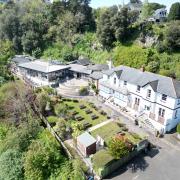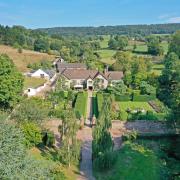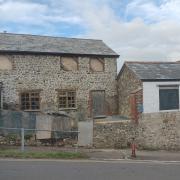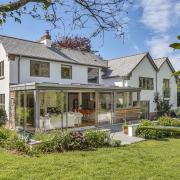Ex-Wimbledon tennis player Penny Moor, a contemporary of Billie Jean King, Yvonne Goolagong and Virginia Wade, is back in Devon after years in North Carolina. She has now turned her attentions to the renovation of her mother's 1930s bungalow. The ...
In hindsight, it seemed quite prophetic that I should be visiting the home of a former Ladies' Tennis Association player almost on the eve of the 2007 American Open, because Penny Moor has lived in America for most of her adult life during, and after, her days on the tour and even ran a tennis and country club in North Carolina for a time. She came back to Devon eight years ago to help look after her ailing mother and inherited her bungalow when she died. Since then, she and her husband of two years have transformed the once standard 1930s bungalow into something spectacular, which has had a dramatic impact on the street scene. Now you wouldn't recognise it; gone is the anodyne suburban look, replaced by a slick multi-dormered frontage. Swept away is the clichéd privet-hedge and floral-bordered front garden, and in its place is a gravelled in-and-out driveway more reminiscent of the affluent residential districts of America. It's hardly surprising because Penny has rubbed shoulders with the rich and famous throughout her career and, although she never achieved superstardom, she did at least make the top 100 on the women's circuit. She played Wimbledon four times and made a living that allowed her to travel the world.
The bungalow (now more of a two-storey house) is a mix of decor and deliberately so.
"Along with the bungalow I inherited a lot of my mother's furniture, which she in turn had inherited from her father, who was an antiques dealer and a cabinetmaker by profession. As well as holding great sentimental value, the pieces my grandfather made are sturdily beautiful and I obviously wanted to hold on to them. But I also wanted to modernise the bungalow more along the lines of what I had been used to in America."
One such example of her grandfather's work retained in the traditional living room is an early electric standard lamp in solid walnut mahogany burl. There's also a wooden tea caddy and an ornate Canterbury. Out in the hallway is Penny's childhood roll-top desk and chair, lovingly crafted by her grandfather, and in the original dining room, now converted into a reading/writing room, is a bureau and table that he made. One more concession to the traditional is the original front bedroom in pink chintz: "I kept this traditionally girlie," Penny explained, "and, hopefully, it creates a warm feel."
Antique pieces in a modern environment don't always sit easily, although it can work. Penny overcame this potential problem by retaining a traditional 1930s core to the building, to house all those treasured antiques, whilst feeling free to refine the remainder of the redevelopment to her vision. It's a solution that works well and accommodates Penny's personal requirements precisely. The long narrow corridor that now forms the spine of the house is the dividing line between the old and the new and also serves as a gallery for the old family photographs. Prime amongst these are the sepia-tinted photographs of her mother as a young girl - she later went on to become a professional dancer and dance teacher before running a pub and restaurant with Penny's late father before they retired.
Whilst the old lounge may house the soul of the old property, the beating heart is indisputably the new kitchen and conservatory area, featuring two specially commissioned pieces, a modern stained-glass internal window made by a friend, Terri Cooke from Budleigh Salterton, and a wood and stainless-steel sideboard made by local specialist manufacturers, Devon Farm Forge and Furniture. "The window was one of the original windows on the outside wall of the bungalow," Penny told me, "but I kept it specially to form a feature." This space has a contemporary feel rather than a 'modern' one. "To me, modern always denotes something stark and clinical," Penny said. "It also has the potential of dating too quickly. That's why I opted for a combination of wood and stainless steel which, I hope, will retain its appeal for much longer. I love this space. It has worked just as I imagined it would. I wanted a light and airy space that was also warm-looking, and the architects, Harris McMillan, have achieved just that."
Warm it certainly was, with the unaccustomed summer sun beating down through the conservatory roof - "but it's wonderfully cool with a through draught," Penny explained, leading through into the garden. There isn't much of it, and it rises up to what had been a Devon hedge before Penny removed it to give themselves more of a view, although the front, with dormer windows to the new extensions, commands the best of the views.
There are two staircases to the upper floor, one to the guest suites and the other to the master suite. In all it took just over a year to carry out the refurbishment, for most of which Penny and her husband were camping out in one room or another. "The architects were project-managing for us, but obviously they couldn't be here the whole time, and I think the builders (Hodges and Bridle) began to wish that we weren't here all the time by the end!"
If downstairs is a tribute to her grandfather's era, upstairs typifies modern living, with every possible advantage taken to conserve and use space. There are, for example, paintings hung at shin-level - and very effective they are as a decorative element. Two features of the guest suite are an Italian leather chair - about the only concession to Art Deco in the whole place - and a 100%-washable silk bedspread.
Upstairs is also something of a memory bank of Penny's own life. Wooden tennis rackets, looking like something a petulant McEnroe might have left around an umpire's head in his heyday, line the walls of her office space, and framed newspaper clippings remind her of her days on the circuit and later when marketing special events with a no-less-petulant Nastase. Billie Jean King (with whom Penny once gave tennis clinics), Yvonne Goolagong and Rosie Casals are all contemporaries of hers on the circuit and Virginia Wade is a particular friend - she recently performed the opening ceremony for a project in which Penny's husband was involved. During Penny's playing days she even met John Wayne, staying on his tennis ranch and teaching his wife to play, and was invited to his daughter's 21st birthday party on California's Newport Beach. "That's the sort of thing I would never have done if I hadn't been involved in tennis," Penny said, "and it's being associated with socialites like that and the type of houses they lived in which has obviously influenced the style I chose to adopt for my own home - albeit much more modest."
Although Penny may not have made the mega-bucks that the youngsters now have access to, she feels, on balance, that life on the tennis circuit during the latter part of the '60s and early '70s was immensely preferable to what it is now. "We were housed with families then - there was lots of hospitality and a lot of camaraderie. Nowadays it's all aeroplanes and hotels and pressure. I feel I had the best of both worlds. I made a living, I got to see the world, and I got to compete against the best of the day. I had a great time."
There have been three strands to Penny Moor's life - tennis professional, event organiser (when her playing days were over) and, latterly, agent for bespoke accessories for the furniture trade. "I dropped into that through my tennis club in North Carolina," Penny told me. "I'd never imagined that furniture was something I would ever get involved with but North Carolina used to be the furniture capital of the world, with numerous manufacturers there. Many members in the club were in the furniture business and, although manufacturing has declined now, it's still home to the largest furniture fair in the world. Being a small place, there aren't enough hotels to go around, so, like they do in Wimbledon, people are in the habit of letting out their houses to exhibitors. It was at a dinner party at the tennis club that I happened to mention I was returning to England shortly, and a manufacturer of occasional iron tables asked me to be an agent for them - they particularly wanted a Brit to represent them over here. That then led me to represent a number of lighting and accessory companies, The Natural Light being one of them. So that's what I've been doing lately and, although I now live here, I do pop back to America once or twice a year, although I'm phasing that out now in preparation for retirement and to work more with the local community."
And her new home will certainly be a comfortable place from which to do that. Just how comfortable, people will be able to judge for themselves shortly, because Penny is holding a fundraising day on 27 October in aid of the local Mardon Neuro-Rehabilitation Centre, when she hopes to lay on a traditional English tea in a less-than-traditional English setting. Details of the event can be obtained from the Mardon Centre and the Fundraising Chairman, Val Dixon, (tel 01392 461926.
MALCOLM TWIGG



